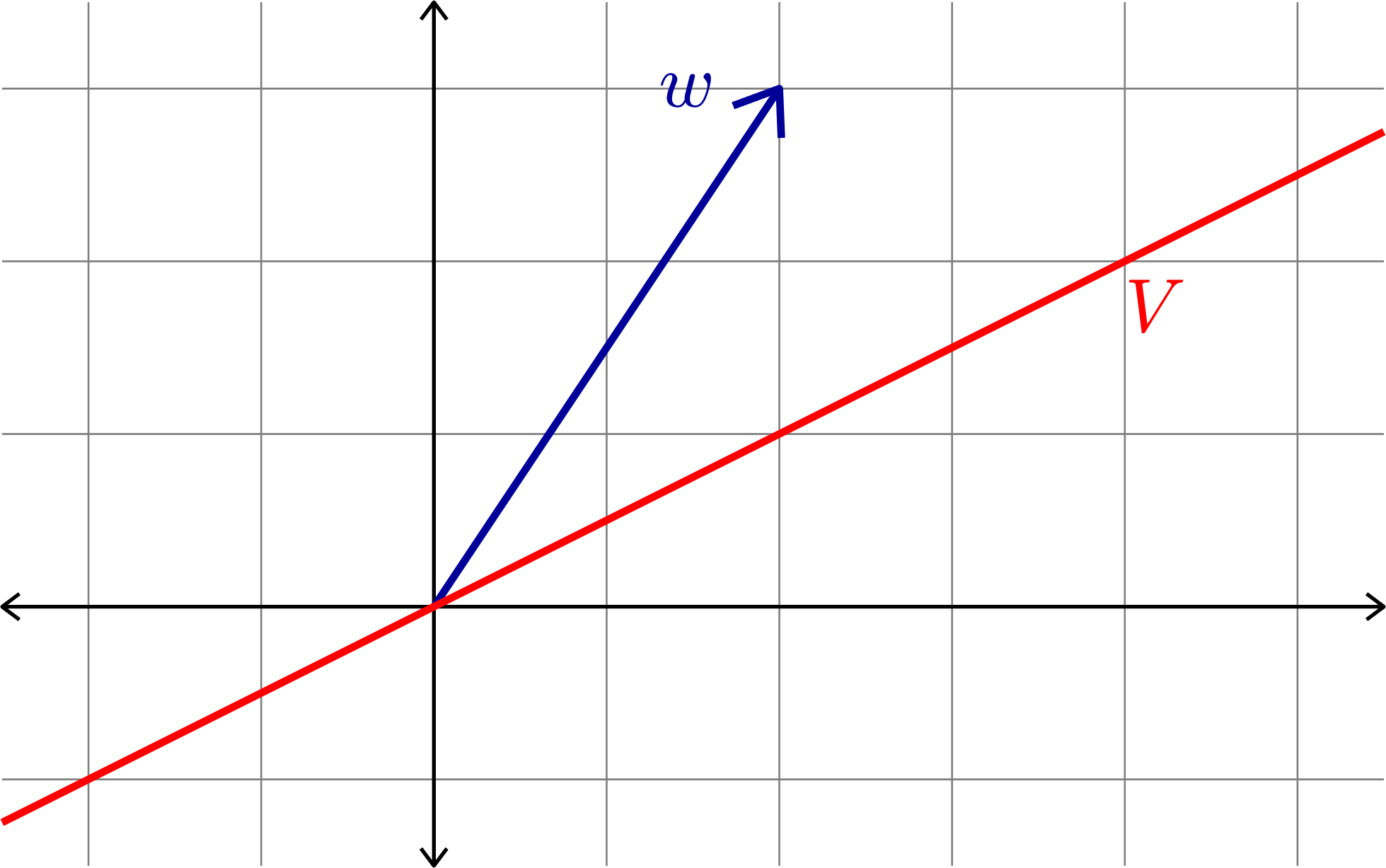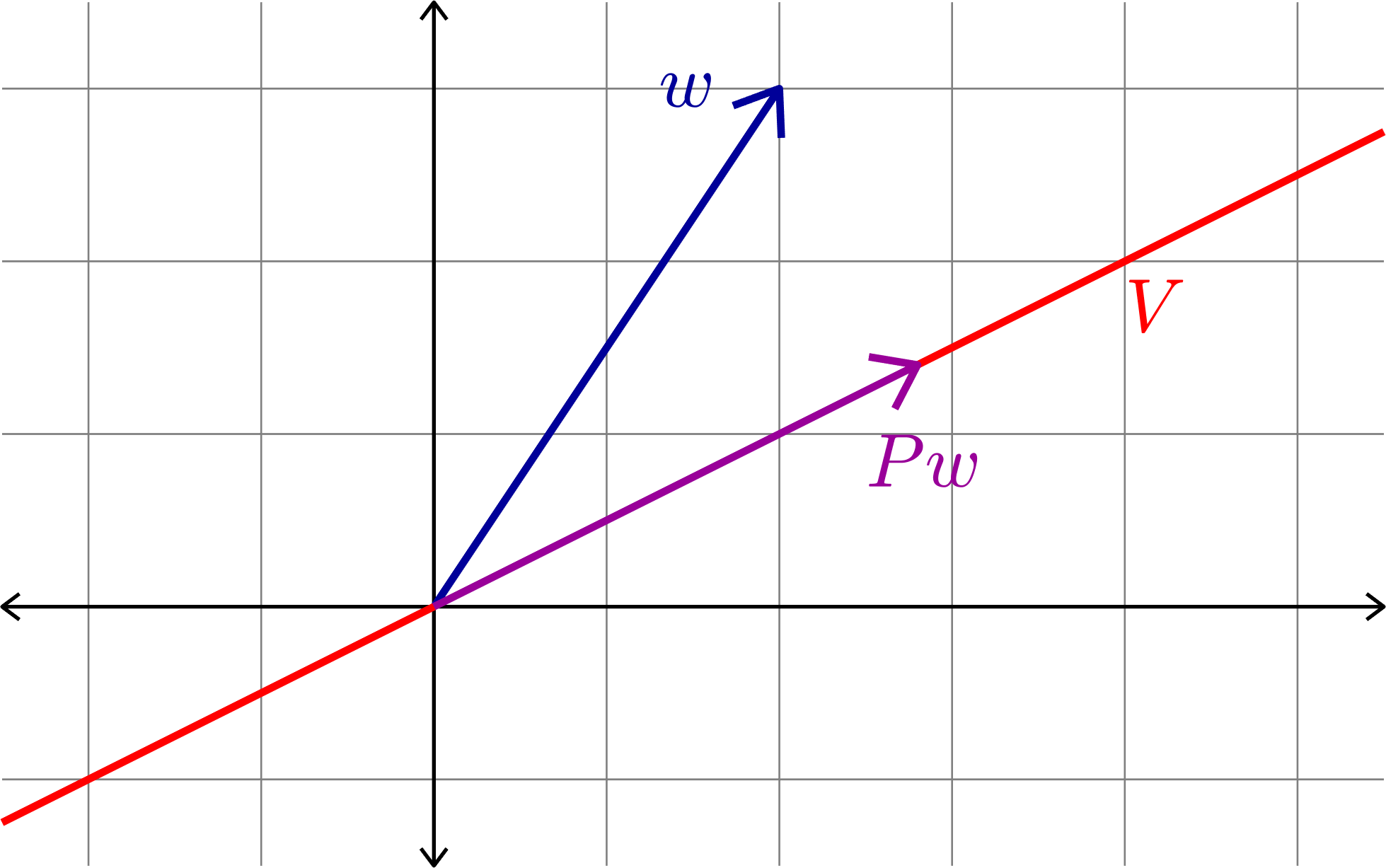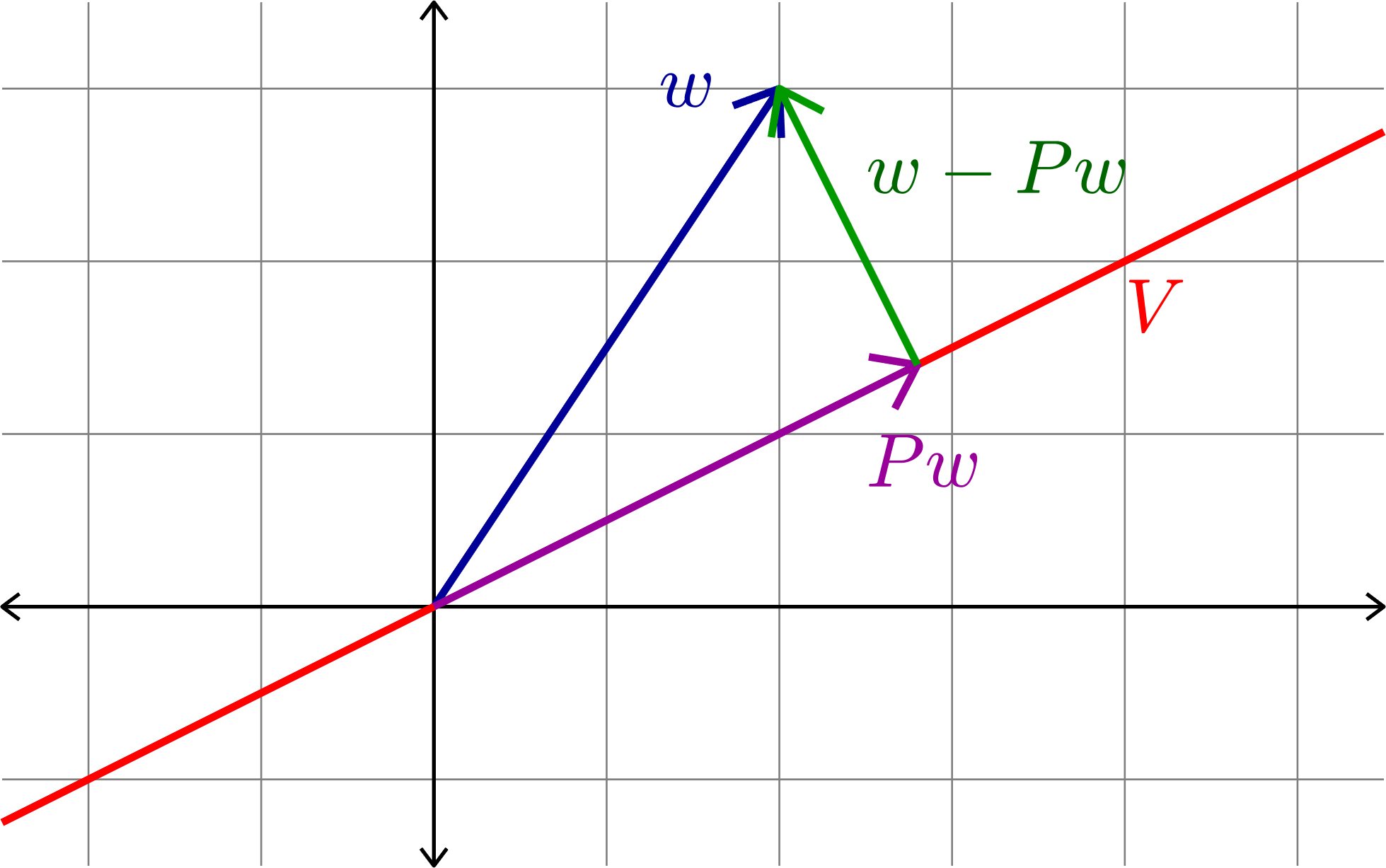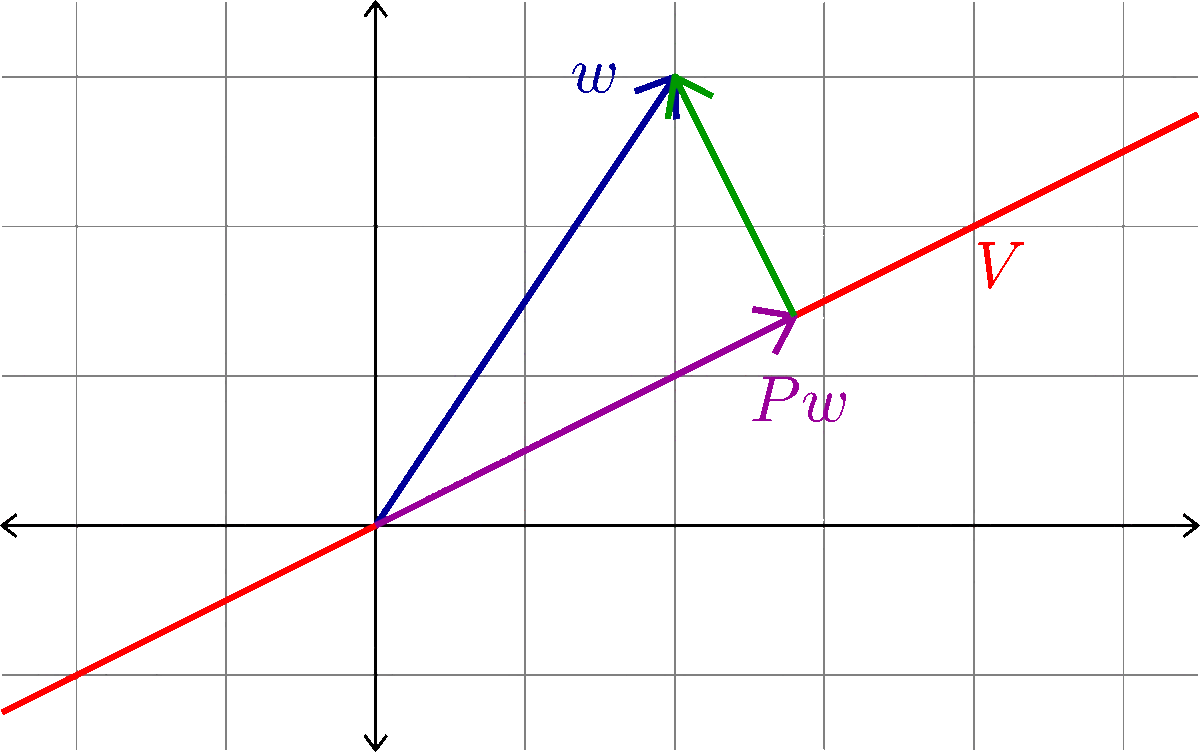Day 18:
Orthogonal projections and Gram-Schmidt 2
Theorem (the Cauchy-Schwarz inequality). Suppose \(V\) is an inner product space. If \(v,w\in V\), then
\[|\langle v,w\rangle|\leq \|v\|\|w\|.\]
Moreover, if equality occurs, then \(v\) and \(w\) are dependent.
Proof. If \(v=0\) then both sides of the inequality are zero, hence we are done. Moreover, note that \(v\) and \(w\) are dependent.
Suppose \(v\neq 0\). Define the scalar \(c = \frac{\langle v,w\rangle}{\|v\|^2}\), and compute
\[ \]
\[ = \|w\|^{2} - 2\frac{\langle v,w\rangle}{\|v\|^2}\langle w,v\rangle + \frac{|\langle v,w\rangle|^2}{\|v\|^4}\|v\|^{2} = \|w\|^{2} - \frac{|\langle v,w\rangle|^2}{\|v\|^2}\]
\[0 \leq \|w-cv\|^{2} = \|w\|^{2} - 2\langle w,cv\rangle + \|cv\|^{2} = \|w\|^{2} - 2c\langle w,v\rangle + c^2\|v\|^{2}\]
Rearranging this inequality we have
\[\frac{|\langle v,w\rangle|^2}{\|v\|^2}\leq \|w\|^{2}.\]
Note, if this inequality is actually equality, then we have \(\|w-cv\|=0\), that is \(w-cv=0\). This implies \(v\) and \(w\) are dependent. \(\Box\)
Theorem (the Triangle inequality). Suppose \(V\) is an inner product space. If \(v,w\in V\), then
\[\|v+w\|\leq \|v\|+\|w\|.\]
Moreover, if equality occurs, then \(v\) and \(w\) are dependent.
Proof. First, note that \(\langle v,w\rangle\leq |\langle v,w\rangle|\). Using the polarization identity and the Cauchy-Schwarz inequality we have
\[\leq \|v\|^{2} + 2\|v\|\|w\| + \|w\|^{2} = \big(\|v\|+\|w\|\big)^{2}.\]
\[\leq \|v\|^{2} + 2|\langle v,w\rangle| + \|w\|^{2}.\]
\[\|v+w\|^{2} = \|v\|^{2}+2\langle v,w\rangle + \|w\|^{2}\]
Note that if \(\|v+w\|=\|v\|+\|w\|\), then we must have
\[\|v\|^{2} + 2|\langle v,w\rangle| + \|w\|^{2} = \|v\|^{2} + 2\|v\|\|w\| + \|w\|^{2}\]
and thus \(|\langle v,w\rangle|=\|v\|\|w\|\). By the Cauchy-Schwarz inequality, this implies \(v\) and \(w\) are dependent. \(\Box\)
Quiz.
- For \(x,y\in\mathbb{R}^{2}\) such that \(\langle x,y\rangle = 2\) it _______________ holds that \(\|x\|=\|y\|=1\).
- For \(x,y\in\mathbb{R}^{2}\) such that \(\langle x,y\rangle = 0\) it _______________ holds that \(|\langle x,y\rangle| = \|x\|\|y\|\).
- For normalized \(x,y\in\mathbb{R}^{2}\) such that \(\|x+y\|^{2} = \|x\|^{2} + \|y\|^{2}\) it _______________ holds that \(|\langle x,y\rangle| = \|x\|\|y\|\).
- For nonzero vectors \(x,y\in\mathbb{R}^{n}\) it _______________ holds that \(\|x+y\|^{2} = \|x\|^{2}+\|y\|^{2}\) and \(\|x+y\|=\|x\|+\|y\|\).
never
sometimes
never
never
Orthogonal Projection
Given a subspace \(V\subset \R^{n}\) we want to define an orthogonal projection onto \(V\). That is, an \(n\times n\) matrix \(P\) with the following properties:
- \(Pw\in V\) for all \(w\in\R^{n}\)
- \(Pv=v\) for all \(v\in V\)
- \(Pw\cdot (w-Pw)=0\) for all \(w\in\R^{n}\)




Orthogonal Projection
Example 1. If
\[V = \text{span}\left\{\begin{bmatrix} 1\\ 0\end{bmatrix}\right\}\]
then
\[P = \begin{bmatrix} 1 & 0\\ 0 & 0\end{bmatrix}\]
is the orthogonal projection onto \(V\).
1. If \(x = \begin{bmatrix} x_{1}\\ x_{2}\end{bmatrix}\in \R^{2}\), then \(Px = \begin{bmatrix} x_{1}\\ 0\end{bmatrix} = x_{1}\begin{bmatrix} 1\\ 0\end{bmatrix} \in V\)
2. If \(x\in V\), then \(x = \begin{bmatrix} x_{1}\\ 0\end{bmatrix}\) for some \(x_{1}\in\R\), then \(Px = \begin{bmatrix} x_{1}\\ 0\end{bmatrix} = x\)
Orthogonal Projection
Example 1 continued.
3. Let \(w = \begin{bmatrix} w_{1}\\ w_{2}\end{bmatrix}\)
\(Pw = \begin{bmatrix} w_{1}\\ 0\end{bmatrix}\) and \(w-Pw = \begin{bmatrix} w_{1}\\ w_{2}\end{bmatrix} - \begin{bmatrix} w_{1}\\ 0\end{bmatrix} = \begin{bmatrix} 0\\ w_{2}\end{bmatrix}\)
Thus,
\[Pw\cdot (w-Pw) = \begin{bmatrix} w_{1}\\ 0\end{bmatrix}\cdot \begin{bmatrix} 0\\ w_{2}\end{bmatrix} = w_{1}\cdot 0 + 0\cdot w_{2} = 0\]
Orthogonal Projection
Example 2. If
\[W = \text{span}\left\{\begin{bmatrix} 1\\ 1\\ 1\end{bmatrix}, \begin{bmatrix} 1\\ -1\\ 0\end{bmatrix}\right\}\]
then
\[Q = \frac{1}{6}\begin{bmatrix} 5 & -1 & 2\\ -1 & 5 & 2\\ 2 & 2 & 2\end{bmatrix}\]
is the orthogonal projection onto \(W\).
Note that
\(\dfrac{1}{6}\begin{bmatrix} 5 & -1 & 2\\ -1 & 5 & 2\\ 2 & 2 & 2\end{bmatrix}\begin{bmatrix} 1\\ 1\\ 1\end{bmatrix} = \begin{bmatrix} 1\\ 1\\ 1\end{bmatrix}\) and \(\dfrac{1}{6}\begin{bmatrix} 5 & -1 & 2\\ -1 & 5 & 2\\ 2 & 2 & 2\end{bmatrix}\begin{bmatrix} 1\\ -1\\ 0\end{bmatrix} = \begin{bmatrix} 1\\ -1\\ 0\end{bmatrix}\)
Orthogonal Projection
Example 2 continued.
If \(x\in W\), then \(x = a\begin{bmatrix} 1\\ 1\\ 1\end{bmatrix}+b\begin{bmatrix} 1\\ -1\\ 0\end{bmatrix}\) for some \(a,b\in\R\)
Thus
\(Qx = \dfrac{1}{6}\begin{bmatrix} 5 & -1 & 2\\ -1 & 5 & 2\\ 2 & 2 & 2\end{bmatrix}\left( a\begin{bmatrix} 1\\ 1\\ 1\end{bmatrix}+b\begin{bmatrix} 1\\ -1\\ 0\end{bmatrix}\right)\)
\(= \dfrac{a}{6}\begin{bmatrix} 5 & -1 & 2\\ -1 & 5 & 2\\ 2 & 2 & 2\end{bmatrix} \begin{bmatrix} 1\\ 1\\ 1\end{bmatrix}+\dfrac{b}{6}\begin{bmatrix} 5 & -1 & 2\\ -1 & 5 & 2\\ 2 & 2 & 2\end{bmatrix} \begin{bmatrix} 1\\ -1\\ 0\end{bmatrix}\)
\(= a\begin{bmatrix} 1\\ 1\\ 1\end{bmatrix}+b\begin{bmatrix} 1\\ -1\\ 0\end{bmatrix} = x\)
This proves that property 2 of an orthogonal projection holds. It is left to you to verify the other two properties hold.
How to find an orthogonal projection matrix
Proposition. Assume \(V\subset\R^{n}\) is a subspace and \(\{v_{1},\ldots,v_{k}\}\) is an orthonormal basis for \(V\). If \[A = \begin{bmatrix} v_{1} & v_{2} & \cdots & v_{k}\end{bmatrix},\]
then the matrix \(P = AA^{\top}\) is the orthogonal projection onto \(V\).
Proof. We will show that \(P\) has all of the desired properties. From the discussion earlier we have \(AA^{\top}v = v\) for all \(v\in V\).
Let \(w\in\R^{n}\). It is clear that \(AA^{\top}w\in V\) since it is a linear combination of the columns of \(A\), which are elements of the basis for \(V\).
Since \(Pw\in V\), we have \(P^2w = Pw\). Additionally, \(P^{\top} = (AA^{\top})^{\top} = (A^{\top})^{\top}A^{\top} = AA^{\top}=P\). Using this, we have
\(\Box\)
\[= (w^{\top} P)(w-Pw) = w^{\top}Pw - w^{\top}P^{2}w = 0.\]
\[(Pw)\cdot (w-Pw) = (Pw)^{\top}(w-Pw)\]
Example. Let
\[V = \left\{\begin{bmatrix}a\\ b\\ c \end{bmatrix} : a+b = 0\right\}\quad\text{and}\quad \mathcal{B}= \left\{\frac{1}{\sqrt{2}}\begin{bmatrix}1\\ -1\\ 0 \end{bmatrix}, \begin{bmatrix}0\\ 0\\ 1 \end{bmatrix}\right\}.\]
Then it is easily checked that \(\mathcal{B}\) is an orthonormal basis for \(V\).
Set \[A = \begin{bmatrix} \frac{1}{\sqrt{2}} & 0\\ -\frac{1}{\sqrt{2}} & 0\\ 0 & 1\end{bmatrix},\]
then
\[P = AA^{\top} = \begin{bmatrix} \frac{1}{2} & -\frac{1}{2} & 0\\ -\frac{1}{2} & \frac{1}{2} & 0\\ 0 & 0 & 1\end{bmatrix}\]
is the orthogonal projection onto \(V\).
Gram-Schmidt
Assume \(V\) is a subspace and \(\{v_{1},\ldots,v_{k}\}\) is a basis for \(V\).
First, we set
\[f_{1}: = \frac{1}{\|v_{1}\|} v_{1}.\]
Next we set
\[w_{2} = v_{2} - (f_{1}\cdot v_{2})f_{1} = v_{2} - f_{1}f_{1}^{\top}v_{2}\]
then we have
\[f_{1}^{\top} w_{2} = f_{1}^{\top} v_{2} - f_{1}^{\top}f_{1}f_{1}^{\top}v_{2}= f_{1}^{\top} v_{2} - \|f_{1}\|^{2} f_{1}^{\top}v_{2} = 0\]
We see that \(f_{1}\) and \(w_{2}\) are orthogonal, but \(\|w_{2}\|=\)???, so we set
\[f_{2}: = \frac{1}{\|w_{2}\|}w_{2}\]
and \(\{f_{1},f_{2}\}\) is an orthonormal set with the same span as \(\{v_{1},v_{2}\}\).
Gram-Schmidt
Now, we can assume we have an orthonormal set \(\{f_{1},\ldots,f_{j}\}\) with the same span as \(\{v_{1},\ldots,v_{j}\}\). Define
\[w_{j+1} = v_{j+1} - \sum_{i=1}^{j}f_{i}(f_{i}^{\top}v_{j+1}).\]
For any \(\ell\leq j\) we have \[f_{\ell}^{\top}w_{j+1} = f_{\ell}^{\top}v_{j+1} - \sum_{i=1}^{j}f_{\ell}^{\top}f_{i}(f_{i}^{\top}v_{j+1}) = f_{\ell}^{\top}v_{j+1} - f_{\ell}^{\top}v_{j+1} = 0.\] Hence, if we set \[f_{j+1} = \frac{1}{\|w_{j+1}\|}w_{j+1}\] then \(\{f_{1},f_{2},\ldots,f_{j+1}\}\) is an orthonormal set with the same span as \(\{v_{1},\ldots,v_{j+1}\}\).
Continue until the \(k\)th step and we have an orthonormal basis \(\{f_{1},\ldots,f_{k}\}\) for \(V\).
Gram-Schmidt example 1
Find an orthonormal basis for \(N([1\ \ 1\ \ 1\ \ 1])\)
Note that \(\left\{\begin{bmatrix} -1\\ 1\\ 0\\ 0\end{bmatrix},\begin{bmatrix} -1\\ 0\\ 1\\ 0\end{bmatrix},\begin{bmatrix} -1\\ 0\\ 0\\ 1\end{bmatrix}\right\}\) is a basis for \(N([1\ \ 1\ \ 1\ \ 1])\)
Set \(f_{1} = \dfrac{1}{\sqrt{2}}\begin{bmatrix} -1\\ 1\\ 0\\ 0\end{bmatrix}\)
Set \(w_{2} = \begin{bmatrix} -1\\ 0\\ 1\\ 0\end{bmatrix} - \left(f_{1}\cdot\begin{bmatrix} -1\\ 0\\ 1\\ 0\end{bmatrix}\right) f_{1} = \begin{bmatrix} -1\\ 0\\ 1\\ 0\end{bmatrix} - \frac{1}{2}\begin{bmatrix} -1\\ 1\\ 0\\ 0\end{bmatrix} = \begin{bmatrix} -\frac{1}{2}\\ -\frac{1}{2}\\ 1\\ 0\end{bmatrix}\)
Set \(f_{2} = \dfrac{w_{2}}{\|w_{2}\|} = \frac{1}{\sqrt{6}}\begin{bmatrix} -1\\ -1\\ 2\\ 0\end{bmatrix}\)
Gram-Schmidt example 1
We already have \(e_{1} = \dfrac{1}{\sqrt{2}}\begin{bmatrix} -1\\ 1\\ 0\\ 0\end{bmatrix},\) and \(e_{2} = \sqrt{\frac{2}{3}}\begin{bmatrix} -\frac{1}{2}\\ -\frac{1}{2}\\ 1\\ 0\end{bmatrix}\)
\(w_{3} = \begin{bmatrix} -1\\ 0\\ 0\\ 1\end{bmatrix} - \left(e_{1}\cdot \begin{bmatrix} -1\\ 0\\ 0\\ 1\end{bmatrix}\right) e_{1} - \left(e_{2}\cdot \begin{bmatrix} -1\\ 0\\ 0\\ 1\end{bmatrix}\right) e_{2}\)
\( = \begin{bmatrix} -1\\ 0\\ 0\\ 1\end{bmatrix} - \left(\frac{1}{\sqrt{2}}\right) \dfrac{1}{\sqrt{2}}\begin{bmatrix} -1\\ 1\\ 0\\ 0\end{bmatrix} - \left(\sqrt{\frac{2}{3}}\cdot \frac{1}{2}\right) \sqrt{\frac{2}{3}}\begin{bmatrix} -\frac{1}{2}\\ -\frac{1}{2}\\ 1\\ 0\end{bmatrix} = \frac{1}{3}\begin{bmatrix} -1\\ -1\\ -1\\ 3\end{bmatrix}\)
\[e_{3}:=\frac{w_{3}}{\|w_{3}\|} = \frac{1}{2\sqrt{3}}\begin{bmatrix} -1\\ -1\\ -1\\ 3\end{bmatrix}\]
Gram-Schmidt example 1
The set \[\left\{\dfrac{1}{\sqrt{2}}\begin{bmatrix} -1\\ 1\\ 0\\ 0\end{bmatrix}, \frac{1}{\sqrt{6}}\begin{bmatrix} -1\\ -1\\ 2\\ 0\end{bmatrix},\frac{1}{2\sqrt{3}}\begin{bmatrix} -1\\ -1\\ -1\\ 3\end{bmatrix}\right\}\] is an orthonormal basis for \(N([1\ \ 1\ \ 1\ \ 1])\)
The set \[\left\{\begin{bmatrix} -1\\ 1\\ 0\\ 0\end{bmatrix}, \begin{bmatrix} -1\\ -1\\ 2\\ 0\end{bmatrix},\begin{bmatrix} -1\\ -1\\ -1\\ 3\end{bmatrix}\right\}\] is an orthogonal basis for \(N([1\ \ 1\ \ 1\ \ 1])\)
Gram-Schmidt Example 2
We wish to find an orthonormal basis for \(C(A)\) where
\[A = \begin{bmatrix} 1 & -1 & 1\\ 1 & 4 & 6\\ -1 & 3 & 1\\ 2 & -3 & 1\end{bmatrix}\]
First, we row reduce to find
\[\text{rref}(A) = \begin{bmatrix} 1 & 0 & 2\\ 0 & 1 & 1\\ 0 & 0 & 0\\ 0 & 0 & 0\end{bmatrix}.\]
This shows us that \(\{v_{1},v_{2}\}\) is a basis for \(C(A)\) where
\[v_{1} = \begin{bmatrix} 1\\ 1 \\ -1\\ 2 \end{bmatrix} \quad\text{and}\quad v_{2}=\begin{bmatrix} -1\\ 4\\ 3\\ -3\end{bmatrix}.\]
Gram-Schmidt Example 2
First, we set
\[f_{1} = \frac{1}{\sqrt{7}}\begin{bmatrix} 1\\ 1 \\ -1\\ 2 \end{bmatrix} = \begin{bmatrix} \frac{1}{\sqrt{7}}\\ \frac{1}{\sqrt{7}} \\ -\frac{1}{\sqrt{7}}\\ \frac{2}{\sqrt{7}} \end{bmatrix} \]
\[f_{1}^{\top}v_{2} = \frac{1}{\sqrt{7}}(-1 + 4 -3-6)=-\frac{6}{\sqrt{7}}\]
\[w_{1} = v_{2} - f_{1}(f_{1}^{\top}v_{2}) = \begin{bmatrix} -1\\ 4\\ 3\\ -3 \end{bmatrix}+\frac{6}{\sqrt{7}}\left(\frac{1}{\sqrt{7}}\begin{bmatrix} 1\\ 1 \\ -1\\ 2 \end{bmatrix}\right) = \begin{bmatrix} -\frac{1}{7}\\ \frac{34}{7}\\ \frac{15}{7}\\ -\frac{9}{7}\end{bmatrix} = \frac{1}{7}\begin{bmatrix} -1\\ 34\\ 15\\ -9\end{bmatrix}\]
\[f_{2} = \frac{w_{2}}{\|w_{2}\|} = \frac{1}{\sqrt{1463}}\begin{bmatrix} -1\\34\\ 15\\ -9\end{bmatrix}\]
Gram-Schmidt Example 2
The set
\[\left\{\frac{1}{\sqrt{7}}\begin{bmatrix} 1\\ 1 \\ -1\\ 2 \end{bmatrix}, \frac{1}{\sqrt{1463}}\begin{bmatrix} -1\\34\\ 15\\ -9\end{bmatrix}\right\}\] is an orthonormal basis for \(C(A)\).
The set
\[\left\{\begin{bmatrix} 1\\ 1 \\ -1\\ 2 \end{bmatrix},\begin{bmatrix} -1\\34\\ 15\\ -9\end{bmatrix}\right\}\] is an orthogonal basis for \(C(A)\).
Linear Algebra Day 18
By John Jasper
Linear Algebra Day 18
- 899



